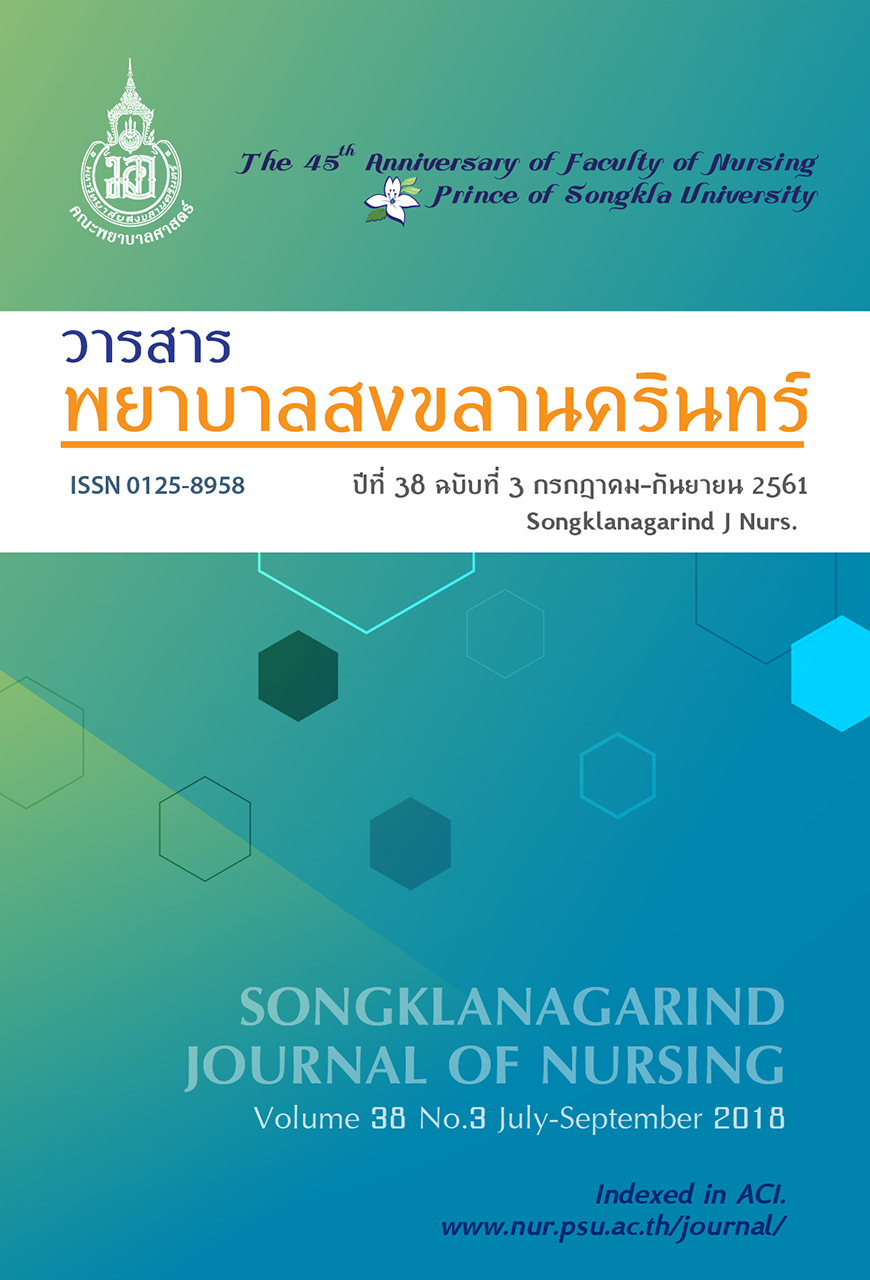Family Members’ Experience in Providing Care for Persons with Stroke: A Phenomenological Study
Main Article Content
Abstract
This phenomenological study aimed to explore family members’ experience in providing care for
persons with stroke at home. Data were collected via in-depth interviews with 18 family members who had
experience of providing care for persons with stroke at home. Data were collected from May 2016 to June
2017. Data were analyzed using van Manen’s Method. Trustworthiness was established following the criteria
of Lincoln and Guba.
Eight themes emerged based on van Manen’s four lived worlds. There were lived body: 1) lack
of knowledge, 2) feeling of burden; lived time: 3) experience of long-term caring, 4) being in a time of
retribution; lived space: 5) being in a cold dark hall, 6) being in a supporting community; and lived relation:
7) caring and sharing among family member, and 8) maintaining strong relationship between the patients
and the family caregivers.
The findings help to understand the phenomena of continuing care for stroke patients at home, supportive
factors in providing care and its limitations. These findings can be used as database in developing projects
to enhance quality of life of stroke patients and family caregivers.
Article Details
References
2. Suwanwela NC. Stroke epidemiology in Thailand. Journal of Stroke. 2014; 16(1): 1-7. doi:10.5853/jos.2014.16.1.1
3. Hanchaiphiboolkul S, Poungvarin N, Nidhinan-dana S, et al. Prevalence of stroke and stroke risk factors in Thailand: Thai Epidemiologic Stroke (TES) Study. J Med Assoc Thai. 2011; 94(4):427-436. Thai.
4. Godwin KM, Ostwald SK, Cron SG,et al. Long-term health-related quality of life of stroke survivors and their spousal caregivers. J Neurosci Nurs. 2013;45(3):147-54. doi: 10.1097/JNN.0b013e31828a410b
5. Jeong YG, Jeong YJ, Kim WC, et al. The mediating effect of caregiver burden on the caregivers’ quality of life. J Phys Ther Sci. 2015;27(5):1543-7. doi: 10.1589/jpts.27.1543.Epub2015 May 26.
6. Ganapathy V, Graham GD, DiBonaventura MD, et al. Caregiver burden, productivity loss, and indirect costs associated with caring for patients with poststroke spasticity. Clin Interv Aging. 2015;6(10):1793-802. doi: 10.2147/CIA.S91123.eCollection2015.
7. Olai L, Borgquist L and Svardsudd K. Lifesituations and the care burden for stroke patients and their informal caregivers in a prospective cohort study. Ups J Med Sci. 2015; 120(4): 290-8. doi: 10.3109/03009734.2015.1049388
8. Department of Medical Service. Guideline for the palliative care [Internet]. Nonthaburi: Ministry of Public Health; 2014 [cited 2018 Jul 1]. Available from: http://www.dms.moph.go.th/dmsweb/cpgcorner/
9. Dans M, Smith T, Back A, et al. NCCN Guidelines Insights: Palliative Care, Version 2.2017. J Natl Compr Canc Netw. 2017;15(8):989–97. doi:10.6004/jnccn.2017.013210.
11. Department of Medical Services. List disease of Palliative care and Functional unit [Internet]. Nonthaburi: Department of Medical Services, Ministry of Health; 2016 [cited 2018 Jul 1]. Available from: http://www.dms.moph.go.th/dmsweb/cpgcorner/cpgcorner26122559.pdf
12. Rangsit City Municipality. [Internet]. Phatum Thani: General information of Rangsit City 2018 [updated 22 Sep 2018; cited 2018 Sep 23]. Available from: http://rangsit.org/New /index.php/th/ 2014-11-07-07-51-09/typography
13. van Manen M. Researching Lived Experience: Human Science for an Action Sensitive Pedagogy. New York: SUNY Press; 1990.
14. Lincoln YS, Guba EG. Naturalistic Inquiry. Newbury Park, C A: Sage Publications; 1985.
15. Nualnetr N, Srikha D. Knowledge on the stroke and behaviors to reduce the risk of stroke among risk persons in Samliam Community, Muang District, Khon Kaen Province. Journal of Medical Technology and Physical Therapy. 2012; 24(3):318-26. Thai.
16. Chuanchan S. Factors related to stroke diseasein hypertension patients, Buengbun Hospital, Sisaket Province. Region 11 Medical Journal. 2015; 29(2): 233-9. Thai.
17. Sug Yoon S, Heller RF, Levi C, et al. Knowledge of stroke risk factors, warning symptoms, and treatment among an Australian urban population. Stroke. 2001; 32(8): 1926-30.
18. Janthayanont D, Srisuwan P, Wisetduangthum K, et al. Attitude and caregiver burden from taking care of stroke patients in Pra Nakorn Si Ayutthaya District Phra Nakhon Si Ayutthaya Province. Journal of Preventive Medicine Association of Thailand. 2011;1(1):58-65. Thai.
19. Notkao D, Kaewmanee C. Factor influence caregiveer burden of stroke caregivers. Paper presented at: The 1 st Ratchathani University National Conference; 2015 July 29; Ratchathani University, Ubon Ratchathani,Thailand.
20. Nilmanat K. The end of life care. Songkla: Chanmuang Press; 2012. Thai.
21. Leelataypin K, Maluesri P, Punnakitikashem P. Service quality assessment in public hospital in Bangkok using SERVQUAL Model. KMUTT Research and Development Journal. 2011;34(4):443-56. Thai.
22. Bureau of Policy and Strategy, Ministry of Public Health. Strategy Indicator and Guideline for Data Management [Internet]. Nonthaburi: Ministry of Public Health; 2014 [cited 2018 Jul 10]. Available from:http://kpo.moph.go.th/webkpo/download/StrategyAndKPI2558_30092557.pdf
23. Winitsorn N, Tangchitmeti P, Yuenyong N, et al. The development of chronic care model for urban older adults by community participation: A case study of Bangkhayaeng community. Journal of Nursing and Education. 2015;8(3):14-32. Thai.
24. Phinyo P, Phinyo K, Limtragool P, et al. Care Improvement for Patients with Stroke Through Community Participation. Songklanagarind J Nurs. 2015;25(2):93-112. Thai.
25. Sornarkas A, Deoisres W, Wacharasin C. Factor influencing family caregivers’s rehabilitation behavior for stroke patients. Journal of Health Science Research. 2015;9(2):86-93. Thai.
26. Bunlikitkul T. Positive experience of family caregivers for stroke patient caring: Toward the way of nurses to promote family experience. Thai Red Cross Nursing Journal. 2011;4(1):1-13. Thai.
27. Koonnarong O, Thaniwatananont P, Kitrungrote L. Caregiving preparedness, family relationships and role strain among caregivers of Muslim stroke patients. Princess of Naradhiwas University Journal. 2012; 4(1): 14-27. Thai .


